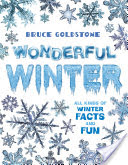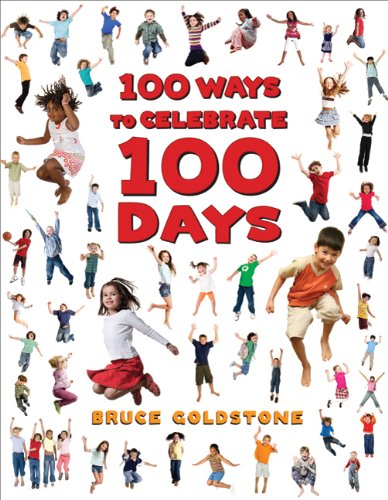Goldstone, Bruce
11 Reviews
(4)
K-3
Filled with colorful photographs of people, plants, animals, and landscapes in a lively format, this book combines very simple and somewhat sophisticated information about the arrival of spring. The brief text mainly focuses on the science of spring but occasionally strays to present more superficial information on seasonal cultural traditions. Craft and activity ideas are appended.
Reviewer: Cyrisse Jaffee
(4)
K-3
This companion to Awesome Autumn is a lively and informative combination of various scientific facts about what happens in winter; spreads of simple labeled photos on topics such as seasonal sensations, phenomena, and activities; and a few craft ideas, including making fake snow from the white powder found in disposable diapers. The shifts in topic are abrupt, and the targeted age level feels inconsistent.
Reviewer: Grace Worcester Greene
(3)
K-3
By pointing out patterns in many disparate things, from honeycombs through beads, tires, and tiles of the Alhambra, Goldstone encourages readers to contemplate the world through an interesting lens. "MathSpeak" sidebars explain geometric terms, such as reflection for flipping a design. Photos and sharp graphics in bright colors illustrate dozens of patterns that nicely expand the minimal but effective text. Pattern-making ideas are appended.
Reviewer: Frieda F. Bostian
(4)
K-3
"If you roll one die, what are the possibilities? Can you roll an even number? That's a possibility!" This is just about the only mundane scenario in this zealous, color-photo-rife, and occasionally overwhelming introduction to the concept of possibility and probability. Other examples revolve around balloon animals, gumballs, and a stuffed animal's vast wardrobe (which the dedicated author made himself).
Reviewer: Nell Beram
(4)
K-3
Many questions and curiosities about the season are answered in this lively, informative volume, from why days get shorter and leaves change color to less-common facts about migrating dolphins and how frost forms; the book occasionally strays from science to present more superficial information on fall cultural traditions. Photographs are nondescript but myriad, and a grouping of crafty activities is appended.
Reviewer: Lela Nargi
(4)
K-3
"List 100." "Snap 100." "Pop 100." Goldstone's one hundred ideas--some clever, others less so--are playfully illustrated with colorful photographs. Though its usefulness beyond the standard hundred-days-of-kindergarten assignment is questionable, this invitingly designed book will attract browsers.
Reviewer: Sarah Novogrodsky
(3)
4-6
This equally eye-catching follow-up to Great Estimations reviews three estimation strategies: eye training, clump counting, and box and count. Photographs of common objects (rubber ducks, popcorn kernels) and more unusual images (skydivers, red blood cells) allow readers to practice their skills while also visually estimating length, weight, size, and volume. Final pages include practice with "Really Big Numbers."
Reviewer: Tanya D. Auger
(3)
4-6
This well-conceived introduction to visual estimation starts off with a colorful photo chock-full of sets of tens--ten toy cars, ten pretzels, ten dominoes, etc.--to help readers get a mental picture of what ten looks like. This "eyeball practice" continues with collections of hundreds and thousands before readers learn and try out two different estimation strategies.
Reviewer: Tanya D. Auger
(3)
K-3
Illustrated by
George Rodrigue.
"Hello. My name is George and I am an artist." So begins this cheerful yet edgy meditation on why Rodrigue, who has been creating the familiar Blue Dog image since the 1980s, always paints his subject blue. Before he reaches his satisfying conclusion, a series of funny question-and-answer pairs ("What color do I paint Blue Dog when I go fishing? / salmon") allows readers to see the famous canine in different hues.
Reviewer: Lolly Robinson
(4)
PS
Illustrated by
Heather Cahoon.
By asking whom the reader will invite to tea, this book cleverly suggests groups that add up to ten: "You might find 6 ballerinas and 4 frogs who love to leap. Or will you ask 5 shepherds and 5 fleecy, fluffy sheep?" The meter often stumbles or shifts, and the digitally generated art, though usually colorful and attractive, is sometimes flat. Overall, however, the concept works.
Reviewer: Anita L. Burkam
(3)
K-3
Illustrated by
Blair Lent.
This delicious combination of richly textured illustrations and tongue-twisting text features an array of hungry animals gathered for a gourmet meal. ("Mosquitoes, moose, mice, and parrots" devour "burritos, juice, rice, and carrots.") Brightly colored collages made from handmade, hand-stamped papers cavort across ample white backgrounds.
Reviewer: Sheryl Lee Saunders
11 reviews
We are currently offering this content for free. Sign up now to activate your personal profile, where you can save articles for future viewing.













